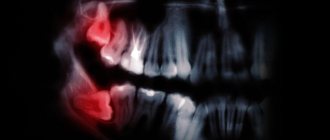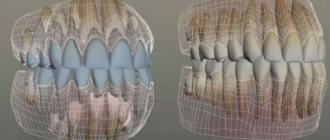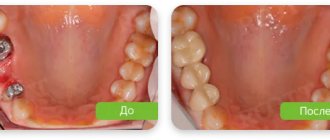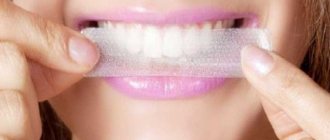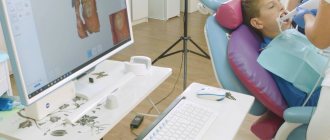From this article you will learn:
- why is wisdom tooth called that?
- how many teeth does a person have?
- What is a dystopic and impacted wisdom tooth?
Wisdom teeth are the last 8 teeth on each side of the dentition (on the upper and lower jaw), which in everyday language are often called “eights”. If we count the number of teeth in each half of the lower and upper jaw, starting with the central incisor, then each wisdom tooth is exactly the eighth tooth. It is on this principle that the serial numbers of teeth are calculated in dentistry. Thus, it turns out that a person will have four such teeth in total - 2 on the upper jaw, and 2 more on the lower jaw.
Wisdom teeth get their name due to the fact that they erupt later than the other teeth in the permanent dentition. Most permanent teeth erupt between 6 and 13 years of age. But as for wisdom teeth, they usually begin to erupt no earlier than 18 years of age (rarely from 14 years of age), and this can happen at 20, 30, and even 40 years. Accordingly, due to the fact that this tooth most often erupts in adulthood, it is called the wisdom tooth.
Wisdom teeth on diagram and x-ray –
Thus, we already understand how many wisdom teeth a person has, and why they got their name. In general, in appearance, the eighth teeth differ little from other molars (6-7 large molars), and their differences are located to a greater extent under the surface of the gums. For example, differences relate to high variability in the number of roots and their shape. It should also be noted that the eighth teeth more often than others have an eruption pathology, and a little less often - an incorrect position in the dentition. Such wisdom teeth are called impacted or dystopic, respectively.
Content:
- Is there a difference? 2.1. Dairy 2.2. Indigenous
- How to tell the difference?
- Is there always a change?
- Are there baby wisdom teeth?
- Can milk root remain in the gums?
- When does radiography come to the rescue?
Children's milk and permanent teeth raise many questions from their parents.
The most attentive mothers and fathers try to clearly monitor the change in temporary bite. It happens that they do not understand whether the baby’s milk units remain in the baby’s mouth or are no longer there. How to determine whether a molar or baby tooth is? To do this you need to have certain information.
Timing and order of eruption of permanent teeth
Normally, the eruption of permanent units occurs 3 to 4 months after the loss of baby teeth. In girls, this process occurs a little earlier and faster than in boys. In both sexes, the first lower molars appear first. Then the sequence of eruption of permanent teeth is approximately the same as for milk teeth and looks as follows.
- 6 - 7 years - central incisors.
- 7 - 8 years - lateral incisors.
- 9 - 12 years - fangs.
- 10 - 12 years - premolars.
- 10 - 12 years - molars.
The eruption of the second molars completes the formation of the permanent dentition.
Is there a difference?
It happens that, trying to determine which children have milk teeth, mothers make a significant wave of their hand and say that there are no differences between the new and old units. In fact, they are.
Dairy
They take their places for closer to two to three years. The very first ones erupt when the baby is 6-12 months old. There are only twenty primary teeth (while there are 32 primary teeth). Therefore, they are arranged in a row quite freely. As the jaw grows, the spaces between them increase significantly. This can be seen with the naked eye.
At the age of 5-6 years, temporary teeth begin to loosen and fall out. This process is completed by the age of 10-12 years.
Indigenous
They appear at five or six years old or a little later. First, molars grow , which become “sixes”. After this, the incisors begin to wobble. They are pushed out by a constant shift.
Children with permanent dentition usually have 28 teeth. The four terminal units (which are popularly called “wise”) usually appear after 20 years. For many, it grows at 30-40 years old. And this is the norm.
Drawing a smiling sun
First we draw a circle, it will be the basis of the image. You can use a compass or trace an object (such as a coin).
Now let's designate the location of the spokes. They can be depicted in different ways: lines, stripes, in the form of trapezoids, triangles, in the form of drops, sunflower petals. The rays can be of different sizes, so the sun will look even more interesting. Choose the shape you like and draw. Erase the basting lines with an eraser.
To make the sun friendly and optimistic, we draw joyful eyes, a small nose, eyebrows and a smile. It can be depicted as a line with raised ends in a U shape in a semicircle. Or you can use the example in the article and look at the photo on how to draw a sun with a smile that reveals your teeth. Add freckles, a bow and handles to make the lamp even more beautiful. Draw all the contours again so that they become lighter and color the drawing.
How to tell the difference?
It is possible to determine which “generation” a tooth belongs to by its:
- Size and shape. Molars are larger, because they are designed for the jaw of an adult. Their edges and boundaries are clear and lumpy. Dairy ones have rounded, smooth edges.
- Blossom. Children's units are white with a bluish tint, adults are yellowish-gray. This is due to the fact that the latter has a higher percentage of mineralizing components. Over the years, they also turn white, but at first they don’t look very presentable.
- Position in the oral cavity. The molars face towards the lips and cheeks. They appear to be slightly tilted. Dairy plants grow evenly and straight.
If we talk about the differences in more detail :
- Six and seven are always radical. You need to count from the middle line of the row (located between the central incisors) towards the ear. In the milk row there are only fives, since there are ten teeth at the bottom and at the top.
- If you have questions regarding the fours and fives, then maximum attention should be paid to their form. Primary teeth have wide crowns and chewing cusps (usually four). If a change has already occurred, then there will be fewer tubercles and the crown will be narrow.
- Temporary fangs are smaller than permanent ones. By the time they fall out, their sharp tips become dull. Instead, units with clearly pointed apexes grow.
- When assessing the nature of the incisors, you need to look at the size. In dairy ones, the width is about 4 mm, the height is 5-6. Permanent ones are usually larger. During the period of change of bite, children's incisors have smooth, even edges, while adults' incisors are lumpy.
Smile with uneven teeth or no teeth
Not everyone has been blessed by nature with beautiful, straight teeth. And some of them died during their lives. But expressing joyful emotions, everyone smiles. Even without teeth. Not everyone has the financial means to clean up the mess, or are you afraid of panicked dentists? Then a closed smile is suitable for you, without exposing your teeth.
If the natural color of your enamel is yellowish and you cannot cope, you need to visit a dentist and undergo a hardware whitening procedure. This is the only way to achieve the desired white color. And all the tricks with toothpaste remain just a successful PR move.
Practical advice
- Find the time, finances and courage to get your teeth in order. The most fervent laughter consists of opening your mouth and exposing your teeth. Otherwise, you will have to constantly cover yourself with your palm.
- Only a sincere smile can attract and bewitch. If you smile with bad intentions, it will look like a smile and others are unlikely to like it. Your eyes should laugh too, because they are called the mirror of the soul.
- Train your facial muscles. In front of the mirror, try to smile so that symmetry appears on your face. It may not work out the first time. When you achieve the desired result, look at the symmetrical smile for a couple of minutes. If you do this regularly, your facial expressions will become accustomed and your muscles will hear you more clearly.
- Take care of your lips. If you don't wear makeup, apply lipstick and give up the bad habit of constantly licking your lips.
%C2%A0
Is there always a change?
Not a single child's tooth should be preserved - they all fall out. Instead of each temporary one, a permanent one is cut through. But it also occurs in dental practice that the rudiment of the root unit is missing. This can be seen in the X-ray of the jaws.
In this case, the life of the baby tooth is extended to the maximum - after all, nothing will grow in its place. When an empty space appears in the dentition, the issue of prosthetics is discussed.
To eliminate partial congenital edentia, you can implant an implant or install a dental bridge. In the first case, there is no need to file adjacent teeth. The doctor, under local anesthesia, installs an artificial titanium root into the jaw tissue. When it takes root, it fixes the dental crown.
In the case of a bridge, it is necessary to depulpate and prepare the neighbors . This is not very healthy, since their service life after such manipulations is significantly reduced. Therefore, young patients who do not have separate molars are recommended by dentists to resort to implantation.
Prosthetics of chewing teeth
We present the end of the treatment straight away, we will not go into the details of implantation.
The patient received the best crowns for her chewing teeth on the right and left. Everything is beautiful and aesthetically pleasing. And most importantly, the functionality of the chewing part of the teeth is completely restored, the occlusion is normal. See for yourself:
Lower jaw
in the area of the fourth segment.
Crowns
installed 4.6, 3.5, 3.6, 3.7:
Finish photos of the lateral projection of the chewing teeth
On right:
And - on the left:
And, of course, I would like to show you the result of successful treatment
of our patient in a smile:
Surgery clinical case:
Atraumatic removal of chewing teeth 2.6, 2.7, 2.4 was performed
Implantation:
Implants were installed in the area of chewing teeth 2.4, 2.6 and 2.7, implantation was carried out with Astra Tech implants.
The choice of Astra Tech implants in this clinical case was due to the fact that Astra Tech is a very reliable system that has proven itself for decades. In general, Astra Tech Implants was at the forefront of implantation in the world. This implantation system has a long-term clinically proven base; they have one of the best indicators for preserving bone at the neck of implants after many years of operation of implants in the oral cavity. Therefore, the Astra Tech implant for prosthetics of chewing teeth, given the subsequent high load on these teeth, is an excellent practical solution.
The surgical part of the protocol and implantation of chewing teeth were carried out by the chief physician of the Research Center, Ph.D. Dakhkilgov M.U.
Can milk root remain in the gums?
If you carefully examine fallen children's teeth, you will not be able to see any semblance of roots. Some mothers unknowingly begin to panic - it seems to them that a significant part of the unit remains in the deep tissues of the gums.
There is no need to worry - this is how it should be. The absence of roots is the result of their gradual resorption. This process starts long before the day of loss. That is why during a natural change (when a tooth falls out without outside help), the child does not experience pain.
Funny tooth with brush and paste
It is very important to teach children hygiene, including oral hygiene. And it is equally important to do this in a form accessible to children. For example, in creativity. To do this, you can, for example, learn to draw human teeth. With a brush and ready-made paste.
The first step is to outline the shape. We draw in general, as in a school biology textbook.
Then we will draw a muzzle for the tooth. After all, this is quite a cartoon character telling children about the rules of dental care. So let's give him big eyes, slightly raised eyebrows and a joyful smile.
Now let's draw two small hands. In them, the tooth firmly holds the toothbrush and tube of toothpaste.
Let's color the drawing. The tooth will be white (except for pink gloves and a smile). Both the brush and the hose are blue. But let's make the bristles on the brush bright orange for contrast.
Our painting is now completely complete. You can hang this photo in the bathroom so that your child does not forget about oral hygiene in the morning. It also helps cope with childhood fear of the dentist.
When does radiography come to the rescue?
Very rarely, but still situations occur in dental practice when even the doctor doubts which tooth he has to work with - a child’s or a molar. In this case, the capabilities of radiography are used. In the photographs you can see:
- length and structural features of the roots;
- presence/absence of radical primordia;
- the location of the unerupted unit and the direction of growth of its incisal edge.
If you need to find out exactly what the situation is with a change in bite in a child, contact your dentist. He will tell you the number of units that should fall out in the near future, and tell you whether it is worth interfering with this process.
How does a human tooth work?
Dental students are required to make enormous amounts of detailed anatomical drawings during their studies. But we will only look at the main parts of the tooth and move on to drawing. All of them have a crown covered with white enamel. Beneath it are hidden the inner layers - dentin, pulp and nerve. Long and strong roots grow deep into the jaw from the tooth: the front ones have one, and the distant ones have two to four.
Functions of a smile
A person’s smile originates in the brain, in its subcortical region (limbic system). By definition, a smile is a reaction to an external stimulus. If you like something, you get positive emotions. If not, then negative.
Each emotion triggers different biochemical processes in the brain. They cause visible changes in the body. A clear example is expressive reactions. This is an external expression of emotions, proof that a person has some experiences, whether they are good or bad.
A smile in psychology is also considered an expression of emotions. If the face of your interlocutor does not express anything, of course, you will treat him with some uncertainty. Even a slight facial expression and a slight smile will change the situation for the better and can evoke love. It is not true?
A smile has other functions.
Communicative
In psychology, smiling is considered one of the ways of non-verbal communication. One of his responsibilities is to tell others what emotions a person is experiencing right now. And that is not all:
- Anyone who smiles automatically inspires confidence in others and instills in them a sense of security.
- Smiling and laughter are contagious. Therefore, by smiling, you can set your interlocutor in a positive mood. Often a smile appears on a person’s face even when viewing photographs of smiling people.
- Using this method of conveying emotions, you can easily express everything you feel right now. We are talking not only about positive emotions, but also about sympathy, apology, contempt, etc.
- A smile tells you what kind of person you are in front of you. It can be used to judge sincerity, good character, and aggression.
In addition, a smile is a corporate communication tool. Its absence can greatly interfere with communication.
Smile from ear to ear - let's draw together
A smile is one of the sunniest, brightest phenomena. Of course, if it is caused by something good. Let's get into this cheerful mood and figure out how to draw a smile with teeth.
First of all, let's draw the general outlines of the lips. Since the mouth will be slightly open, we will draw the outlines wider than with the mouth closed.
Then we will separate the upper lip, lower lip and the distance between them.
Then we will finalize the upper jaw. The teeth should not be the same size - otherwise the smile will resemble a fence.
Now let's repeat the same with the lower jaw. Only here the size of the teeth will be slightly smaller.
After that, let's color our drawing. Let's make the lips a rich red color, the inside of the mouth pink, and the space around it soft pink.
That's it, we completed the task.
Advice from psychologists
One more thing should be said about the miraculous power of a smile. He is able to cheer up even the person from whom he comes from. Psychologists advise immediately after waking up to smile at yourself - warmly, dreamily and gently stretch. It is also worth thinking that the coming day will be positive and successful. Only then will you be able to get out of bed and start your morning routine. It is very important that this seemingly insignificant ritual becomes everyday. When you start thinking positively, you will see how your life will soon change. Smile, laugh as often as possible, and not just in front of the camera.
We hope that after reading this article, you received the answer to the question of how to smile beautifully and will be able to shine with a radiant smile. And one last piece of advice. Look at the smiling face of the child, kind and sincere. Babies cannot smile under duress, which is why their smile is so real. Try it and you will follow their example. Laugh like you don't have a problem, enjoy life for whatever reason, and ignore the stereotype that Russians are people without a smile. You can change this opinion.




